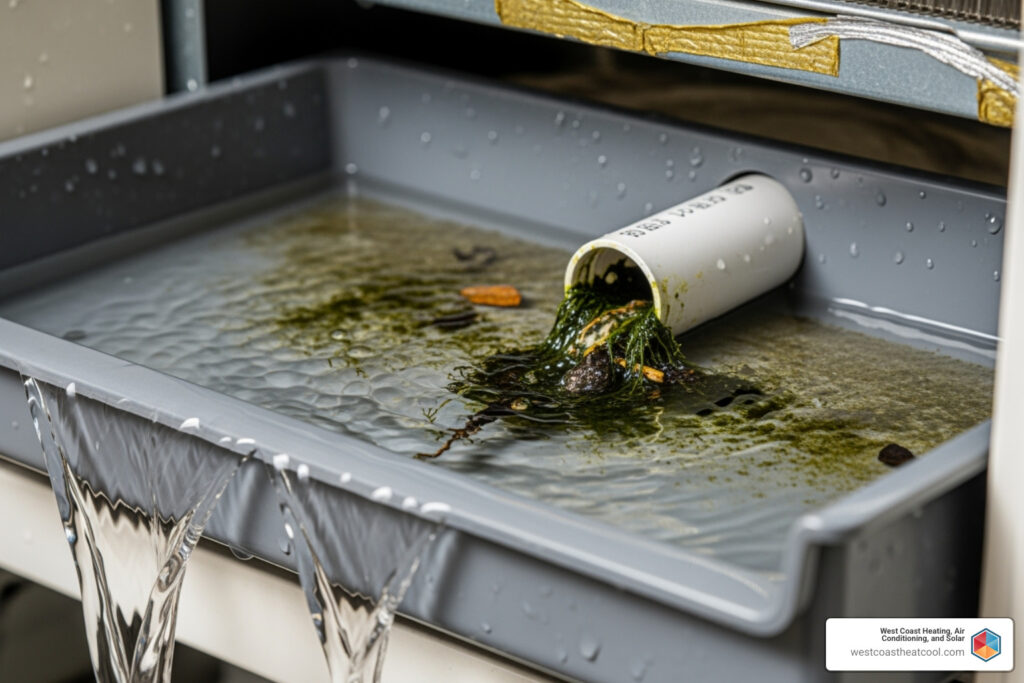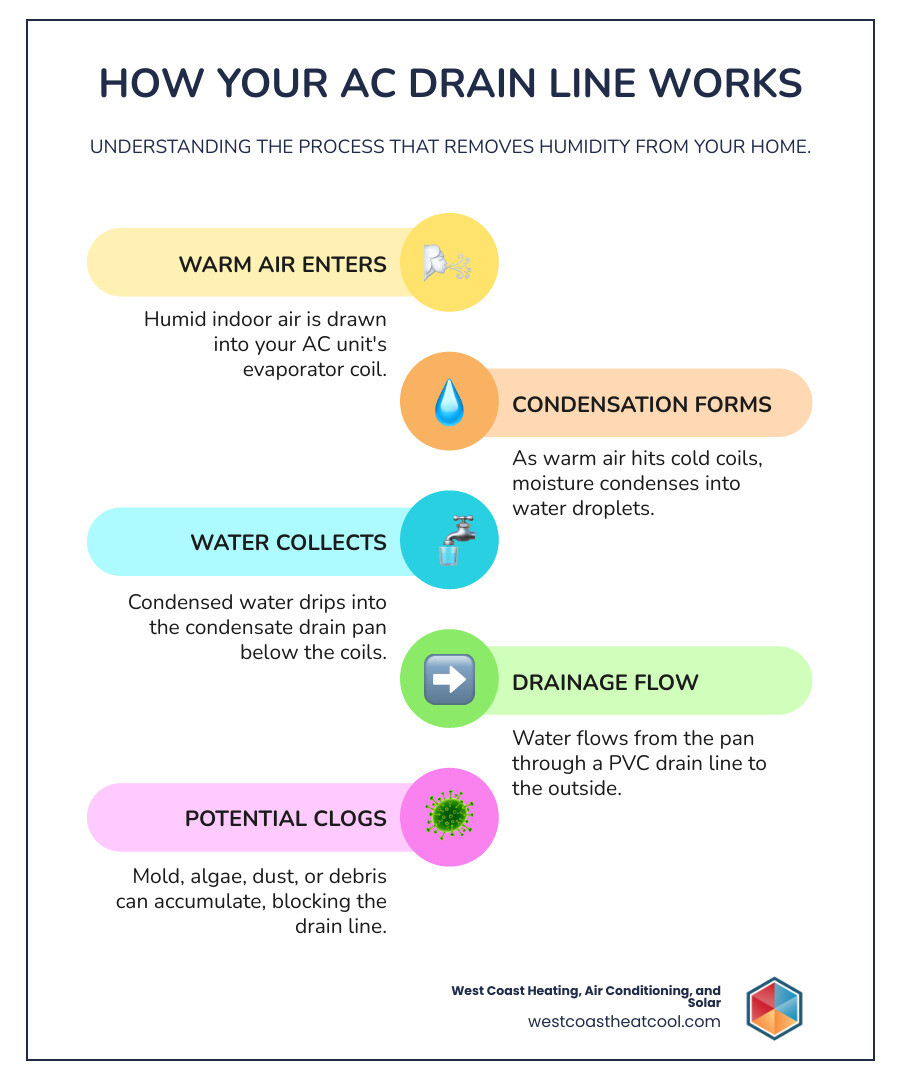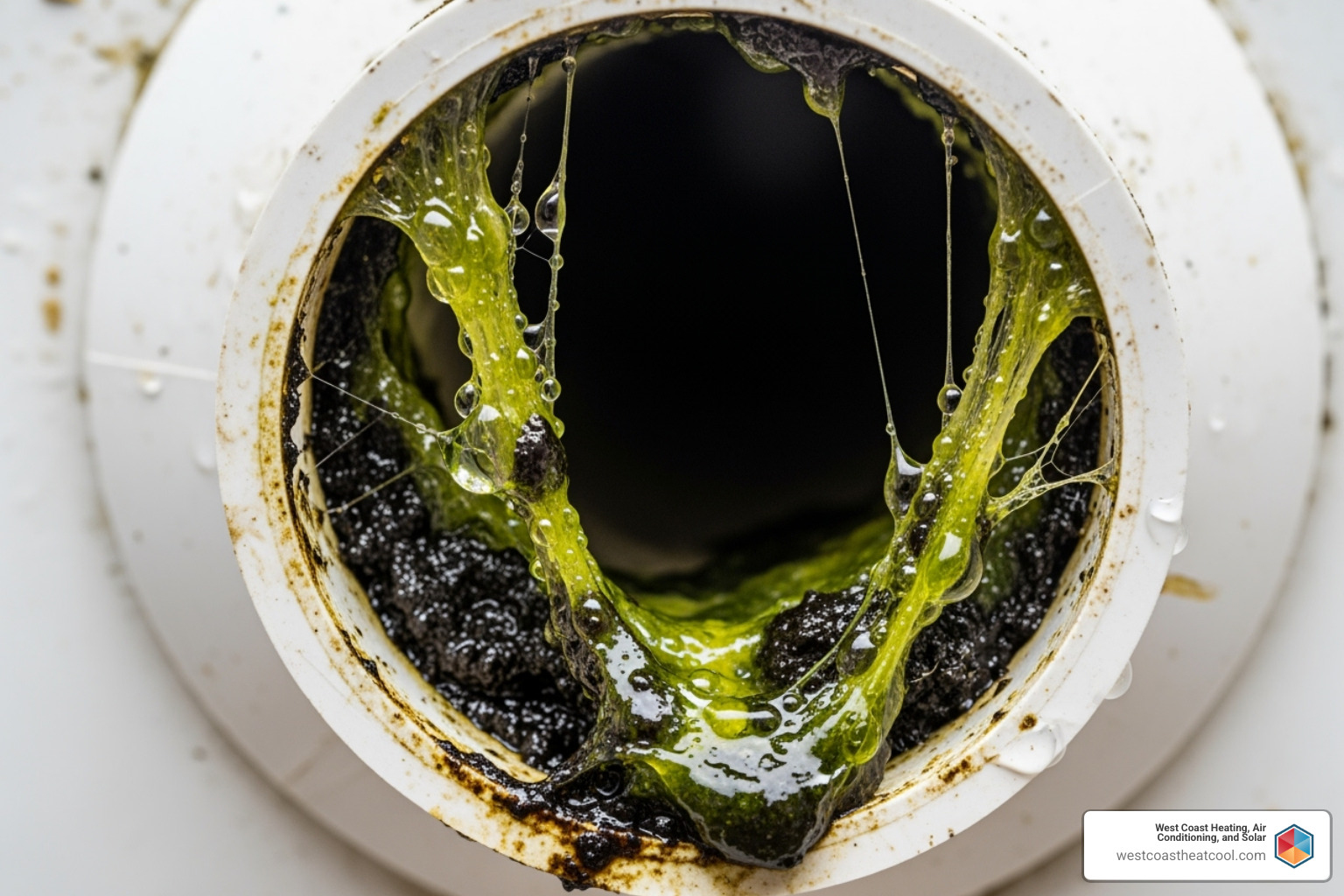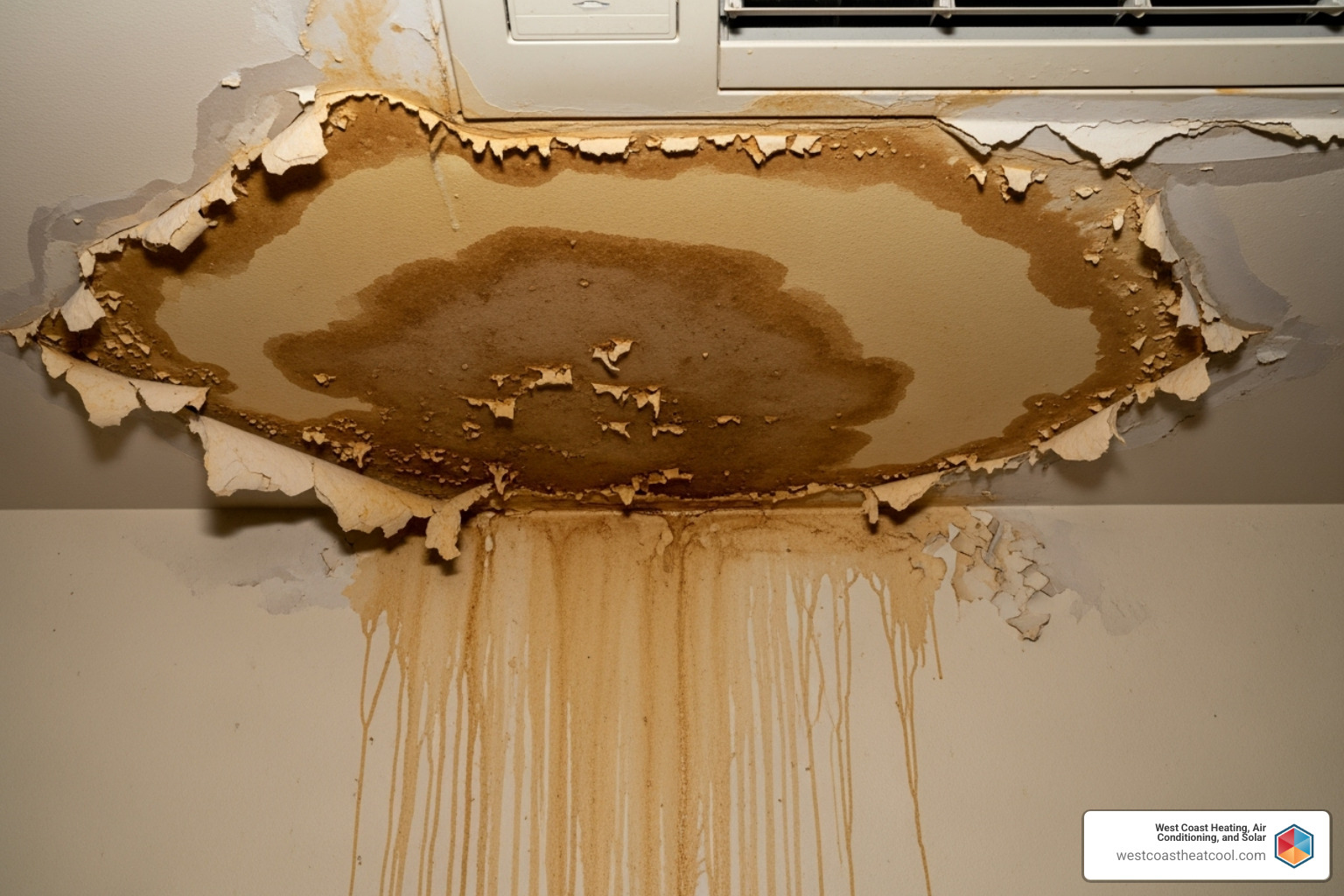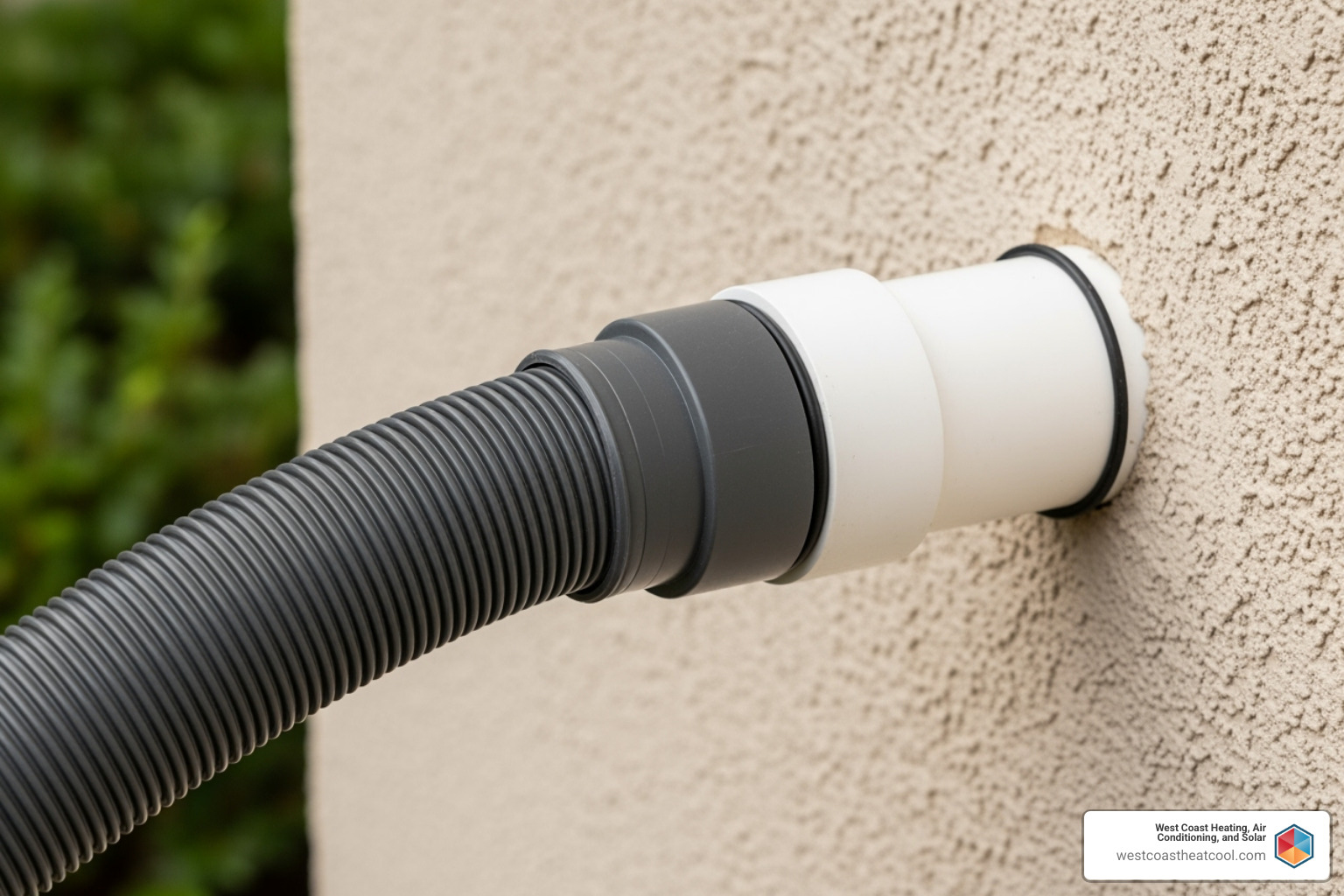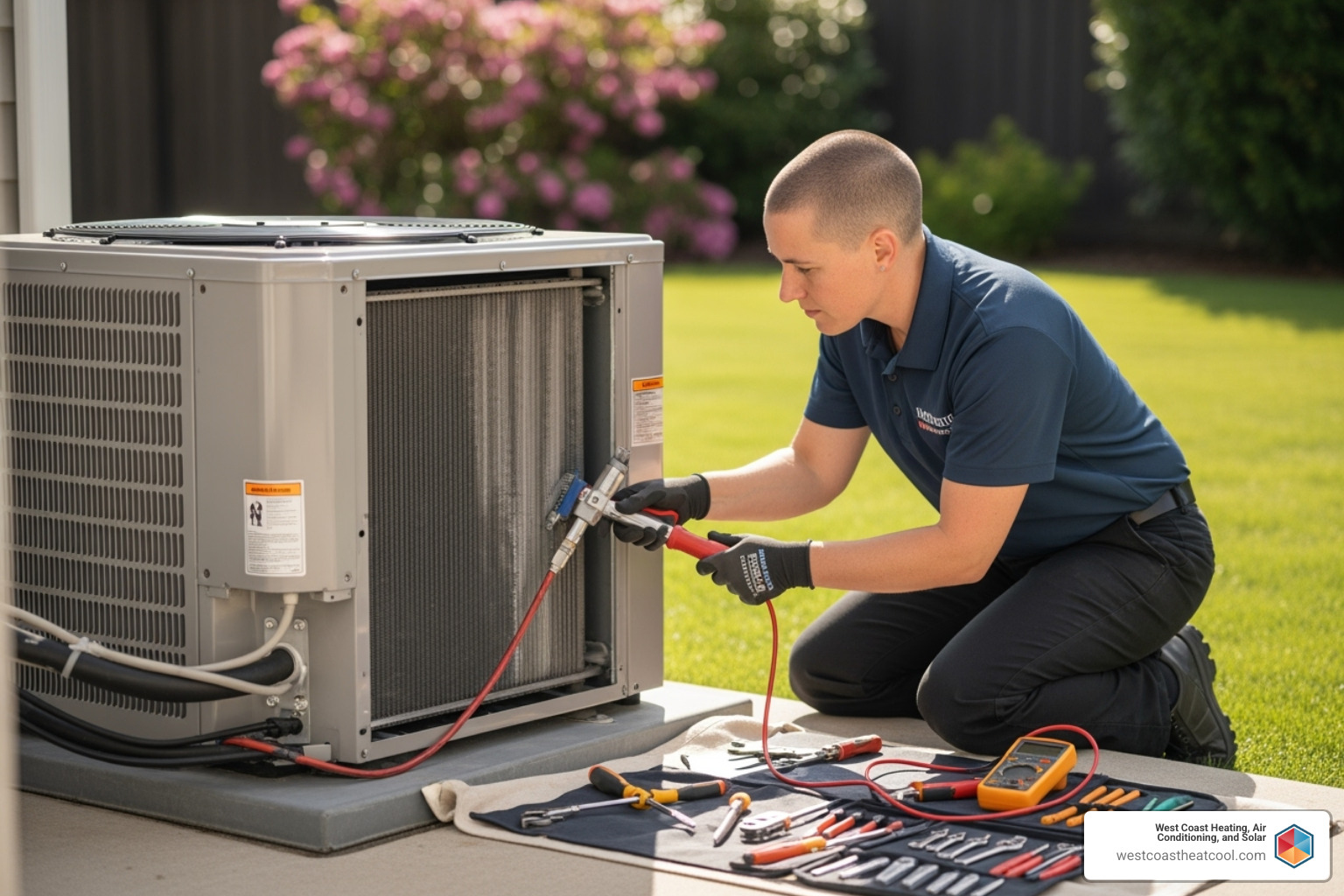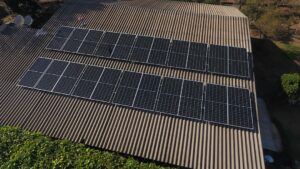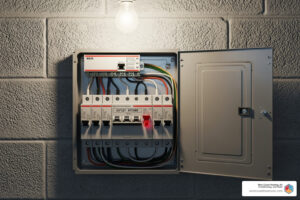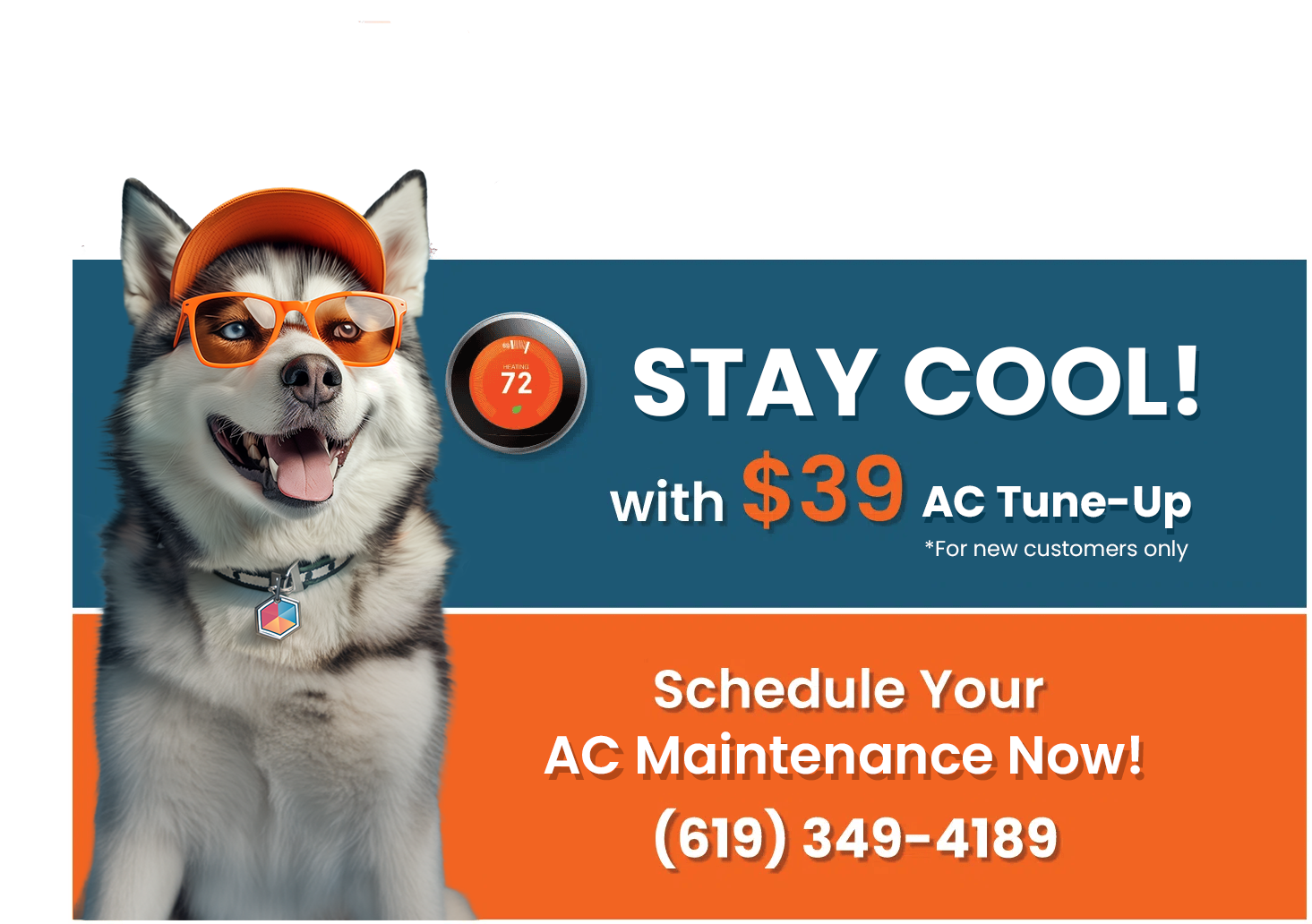Understanding AC Drain Line Clogs: Your Quick Fix Guide
An AC drain line clog is a common HVAC problem, especially in humid climates like San Diego. When your AC removes moisture from the air, the resulting water needs a path to exit your home. If that path is blocked, problems can start quickly.
Quick Solutions for AC Drain Line Clogs:
- Turn off power to your AC system.
- Use a wet/dry vacuum on the outdoor drain line exit.
- Flush with a vinegar solution through the indoor access point.
- Test the system after clearing the blockage.
Warning Signs You Have a Clog:
- Water pooling around your indoor unit
- Musty smells from vents
- AC not cooling properly
- System shutting down unexpectedly
The good news is that most minor clogs cost just $10-50 to fix yourself, while professional service runs $180-220. Catching this early is key to preventing expensive water damage. Your AC pulls humidity from the air by condensing it on cold evaporator coils. This water collects in a drain pan and flows outside through a PVC drain line. When this line is blocked by debris, mold, or algae, water backs up, putting your comfort and your home at risk.
The What, Why, and How of an AC Drain Line Clog
This section explains the fundamentals of your AC’s drainage system, why it gets blocked, the warning signs, and the potential consequences of inaction.
What is an AC Drain Line and What Does it Do?
Your air conditioner acts as a dehumidifier for your home. As warm, humid air passes over the cold evaporator coil, moisture undergoes condensation, turning from vapor into water droplets. These droplets collect in a condensate drain pan below the coil. The AC drain line, a small PVC pipe, then carries this water safely outside your home.
This process is essential for humidity control. The EPA recommends keeping indoor humidity levels between 30-50%. A blocked drain line prevents your AC from dehumidifying properly, leaving your home feeling sticky and uncomfortable.
Common Causes of an AC drain line clog
The dark, damp environment of your drain line is a perfect breeding ground for clogs. Here are the most common culprits:
- Mold, Mildew, and Algae Growth: These organisms thrive in the constant moisture, creating a slimy buildup that obstructs flow. FEMA’s resources show how quickly they can grow.
- Dust and Dirt: Fine dust that bypasses your air filter can mix with condensation, forming a sludge that helps clogs form.
- Improper Installation: If the drain line lacks a sufficient downward slope, water can stand in the pipe, encouraging growth.
- Dirty Air Filters: A clogged filter restricts airflow, which can cause the evaporator coil to freeze. When it thaws, the sudden rush of water can overwhelm the drain. A dirty filter also allows more dust to enter the system.
- Pests and Insects: Small creatures can build nests or get stuck in the outdoor end of the drain line, creating a blockage.
Telltale Signs and Symptoms
Your AC will give you clear signs of a clogged drain line. Be on the lookout for:
- Standing Water: Puddles near your indoor unit are the most obvious sign, caused by an overflowing drain pan.
- Water Damage: Stains on walls or ceilings, warped flooring, or peeling paint near the indoor unit indicate a persistent leak.
- Musty or Moldy Odors: A foul smell from your vents suggests stagnant water and microbial growth.
- Inefficient Cooling: The system may struggle to remove humidity, leaving your home feeling muggy even when the AC is running.
- System Shutdown: Many systems have a safety switch that shuts the unit off if the drain pan fills with water.
- Gurgling Sounds: Bubbling noises from the indoor unit can indicate air struggling to get past a partial blockage.
The Risks of Ignoring an AC drain line clog
Ignoring a clogged AC drain line can lead to serious and expensive problems for your home and wallet.
- Expensive Water Damage: Overflowing water can ruin floors, drywall, and furniture, leading to costly repairs.
- Structural Damage: Persistent moisture can weaken wooden framing and cause rot.
- Poor Indoor Air Quality: Mold and mildew release spores that can trigger allergies and respiratory issues.
- Rust and Corrosion: Constant moisture can damage metal components like the evaporator coil and drain pan.
- Electrical Damage: Water reaching electrical components can cause short circuits and create safety hazards.
- Shortened System Lifespan: The cumulative stress and damage can lead to premature system failure, as noted in the Energy Department’s list of common air conditioner problems.
A simple clog can escalate into thousands of dollars in damage if ignored. Taking action now is a wise investment.
How to Safely Unclog Your AC Drain Line: A Step-by-Step Guide
Clearing a minor AC drain line clog is a manageable DIY task for most homeowners. Before you begin, always turn off all power to your HVAC system for safety.
Step 1: Turn Off Power and Locate the Line
First, switch your thermostat from “Cool” to “Off.” Then, go to your home’s main electrical panel and flip the breaker for your AC system (often labeled “AC,” “Furnace,” or “HVAC”) to the “Off” position.
Next, locate your indoor air handler, which is usually in a closet, attic, basement, or garage. Find the PVC pipe extending from the unit and look for a T-shaped vent with a cap. This is the access point for cleaning the line.
Step 2: Use a Wet/Dry Vacuum
This method is effective for pulling blockages out from the end of the line.
Find the outdoor drain termination point, a short PVC pipe usually located near your outdoor condenser unit. Attach your wet/dry vacuum hose to the end of this pipe, creating a tight seal. You can use duct tape or a rag to help seal the connection for maximum suction.
Turn the vacuum on and let it run for a few minutes. The suction should pull the clog, along with any slime and debris, out of the line.
Step 3: Flush the Line with a Cleaning Solution
After vacuuming, a cleaning flush will help dissolve any remaining buildup.
Return to the indoor access point, remove the cap, and use a funnel to pour a cleaning solution into the tee. A mixture of one part white vinegar to one part warm water is a safe and effective choice. Pour about 1/2 cup of the solution into the line.
Let the solution sit for at least 30 minutes. The vinegar’s acidity will help break down any remaining mold, algae, or slime without harming your pipes.
Important: Never use harsh chemical drain cleaners like Drano. They can damage PVC pipes and metal AC components. For more on safe cleaning, see our guide on Solving AC Drain Line Clogs.
Step 4: Final Flush and System Test
Now, you’ll flush the line and test your work.
Pour a few cups of clean water through the indoor access tee to wash away the loosened debris and vinegar solution. Go outside and confirm that water is flowing freely from the drain line’s exit point. A steady stream means the clog is cleared.
Replace the cap securely on the indoor access point. Then, restore power to your system at the breaker box and turn your thermostat back to “Cool.”
Let the AC run and monitor its performance. Check for any leaks around the indoor unit and drain pan. If water flows smoothly and there are no leaks, you have successfully cleared your AC drain line clog.
Prevention is Key: Keeping Your Drain Line Clear
While knowing how to fix an AC drain line clog is useful, preventing one is even better. Consistent, simple maintenance is the most effective way to avoid the hassle and potential damage of a blockage.
Regular DIY Maintenance
These simple habits can save you from emergency repair calls:
- Monthly Vinegar Flush: Once a month during cooling season, turn off the AC power and pour 1/4 cup of white vinegar into the drain line’s access point. Let it sit for 30 minutes, then flush with water. This inhibits the growth of algae and mold.
- Check the Drain Pan: When you change your air filter, glance at the drain pan to ensure it’s dry and free of debris. Standing water is an early warning sign of a developing clog.
- Clear the Outdoor Exit: Regularly check that the outdoor drain exit is clear of leaves, dirt, and pests so water can flow away freely.
- Change Air Filters Regularly: A clean filter prevents excess dust and debris from entering your system and contributing to clogs. Change filters every 1-3 months.
The Importance of Professional Maintenance
While DIY care is crucial, it doesn’t replace an annual professional tune-up.
Scheduling an air conditioner tune up before the cooling season is the best way to ensure system reliability. Technicians use specialized tools, like high-pressure nitrogen flushes, to thoroughly clean the line and can also clean the evaporator coil, a key part of prevention.
A professional inspection can identify underlying issues like improper drain slope or pipe damage. A technician can also install a condensate overflow safety switch, an inexpensive device that shuts off your AC if water backs up, preventing damage. Our HVAC Services for San Diego Homes include this comprehensive maintenance to keep your system running smoothly.
DIY vs. Professional Help: When to Make the Call
Knowing when to handle an AC drain line clog yourself and when to call a professional can save you time, money, and stress. Many clogs are manageable DIY projects, but some require an expert.
When DIY is a Good Option
You can likely handle the clog yourself if:
- It’s a minor clog and a first-time occurrence.
- There is no visible water damage to your home.
- You are comfortable following the steps outlined in this guide.
- You have the necessary tools (wet/dry vac, funnel) and are looking for a low-cost fix ($10-$50).
If you feel unsure at any point, it’s always best to call for professional help.
When to Call a NATE-certified HVAC technician
It’s time to call a professional if:
- Your DIY methods fail to clear the clog.
- You experience recurring clogs, which suggests an underlying issue like improper installation.
- You see major water damage, such as stained ceilings or warped floors.
- Your AC won’t turn on after you believe the clog is cleared, as a safety switch may have been tripped.
- You suspect electrical issues or see water near electrical components.
- You are simply uncomfortable with the repair.
Professionals use advanced methods like high-pressure nitrogen to clear stubborn blockages that DIY methods can’t. For reliable AC Repair Services in San Diego, our team has the tools and experience to resolve any AC drain line clog safely and effectively.
Frequently Asked Questions about AC Drain Line Clogs
Here are quick answers to the most common questions we hear about AC drain line clogs.
Can a clogged drain line cause an AC system to shut down?
Yes. Most modern AC units have a condensate overflow float switch. If water backs up in the drain pan due to a clog, this switch will automatically shut off the system to prevent water damage. It’s a critical safety feature.
How often should AC drain lines be checked or maintained?
For best results, follow this schedule:
- Monthly: Perform a quick visual inspection of the drain pan and outdoor exit during cooling season.
- Quarterly: Flush the line with a vinegar solution as a preventative measure.
- Annually: Schedule a professional tune-up for a thorough cleaning and inspection. This is a standard part of our HVAC Services for El Cajon Homes and other San Diego areas.
How much does it cost to unclog an AC drain line?
The cost varies depending on the approach:
- DIY: Expect to spend $10 to $50 on supplies like white vinegar and a funnel.
- Professional Service: The cost typically ranges from $180 to $220. This is the best option for severe or recurring clogs that require specialized tools and expertise to resolve correctly and inspect for underlying issues.
Stay Cool and Clog-Free with Proper Maintenance
A clean AC drain line is the unsung hero of your cooling system, essential for protecting your home and ensuring your AC’s health. While this guide empowers you to handle minor clogs, consistent preventative maintenance is the most effective strategy to avoid problems.
Regular maintenance prevents frustrating AC drain line clog situations, keeps your system running efficiently, saves money on energy bills, and extends its lifespan. For comprehensive care in San Diego’s unique climate, trust the experts at West Coast Heating, Air Conditioning, and Solar. Since 1996, our customer-centric approach, transparent pricing, and commitment to quality have provided year-round comfort to our clients.
Whether you need help with a stubborn clog or want to schedule a preventative tune-up, we’re here to help. We proudly serve communities across San Diego County, including Chula Vista, San Diego, Alpine, Bonita, Bonsall, Cardiff, Carlsbad, Coronado, Del Mar, El Cajon, Encinitas, Escondido, Fallbrook, Imperial Beach, La Jolla, Lemon Grove, National City, Oceanside, Poway, Rancho Santa Fe, San Marcos, San Ysidro, Santee, Solana Beach, Spring Valley, Valley Center, and Vista, California.
Contact us today to book your AC repair service in Escondido, CA. We’re committed to keeping you cool and comfortable.

